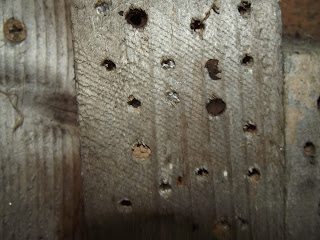This letter to my MP is part of the Blueprint for Water campaign which is being run by a number of wildlife NGOs. http://blueprintforwater.org.uk/
Dear Ms Bradley
Dear Ms Bradley
I
am writing to you as a constituent who lives close to Endon Brook,
Horton Brook and the River Churnet, I regularly walk past or
alongside these water courses (the first two being tributaries of the
third) and enjoy what wildlife there is to be seen. However, none are
currently in a healthy state because they are suffering from:
- pollution from agriculture (i.e. effluent runoff) and road surfaces and sewage;
This photo shows silt and vehicle oils being washed off the A53 iin Endon into storm drains which open into the Endon Brook under Station Road, Endon. Photo of silty water once it reaches the stream below - taken on the same day.
Taken after heavy rainfall on 26.02.15.
This photo shows growths of biotic film and filametous algae and bacteria coating stones in Horton Brook. This is the result of animal manures from local fields and farms entering the water courses and causing eutrophcation, which in turn leads to a reduction in dissolved oxygen in the water. Ultimately this limits which species are able to live in the stream.
This photo was taken in May 2008 after herbicide had been sprayed adjacent to Endon Brook in Station Road, Endon. Pesticides should not be applied next to water courses without permission from the Environment Agency. This is one relatively minor example; I have see worse incidents that this on private farmland adjacent to Endon Brook.

3. excessive silting due to careless soil management and construction work;
This is an old hollow lane, Coalpitford Lane between Endon and Cheddleton where vehicle tyres have eaten in to the old hedge bank. In addition to loosening soil which eventually ends up in water courses, this activity damages our local landscape heritage. In other instances soils is being washed off fields and into water courses.
Silt from limestone chippings in farm gateway being washed into Horton Brook along Gratton Lane, June 2015. Silty suspensions in stream and river water can settle out on to fish and other aquatic creature's eggs, thereby starving them of essential oxygen. Suspended solids also block light to the leaves of aquatic plants which slows photosyntesis and, consequently further reduces oxygen levels in water.
4. channelisation
and tidying up by private landowners;
Creating an artificial "trapezoidal"and self-clearing stream channel leaves an unvegetated, uniform, unatural canal-like channel. This provides far fewer ecological niches for aquatic invertrbrates than does a naturally meandering stream with riparian vegetation and that is allowed to spread out into its flood plain. (And, it reduces down-stream flooding into the bargain).
This section of the River Churnet (near Oakamoor) is taking a more natural course - it is being allowed to erode the cliff slope and deposit a silt bar on the slower flowing side of the river
5. litter;
These photos were taken in Endon. The first is where The Village Brook passes under the A53 and the second is where a tributary of the Endon Brook passes under Station Road.
6. invasive
plants (non-native and native species) smothering less vigorous
aquatic and riparian vegetation, thereby leading to reduced
biodiversity and aesthetic appeal.
Vigorous plant species such as the non-native Hymalayan Balsam and the native nettle are beneftitting from nutrient-rich soils alongside streams and rivers. These plants smother less vigorous species, therby reducing biodiversity. This is the River Churnet in Cheddleton in the summer of 2014.
6.obstructions,
such as pipes, to aquatic wildlife that prevent them from accessing
headwaters;
This is one of the headwater stream os Endon Brook (and eventually the River Churnet). The piping causes the stream water to be rised up a step which will prevent most aquatic organisms from swimming to upstream habitats.
7. misconnections
(of domestic waste pipes to storm drains).
The photos below show very common occurances in local streams; detergent bubbles floating on the surface and forming frothy accumulations where the water is held back by an obstacle. These photos are of Endon Brook where it passes under Station Road. The first was taken in June 2014 and the second, which could be milk or paint, in March 2013. (I reported both these and other incidents to the Enviromnemnt Agency)
These
issues are symptomatic of a bigger, national scandal – just 17% of
rivers across the whole of England are healthy, with many other
rivers being subject to over-abstraction, pollution and poor
management.
This
is bad for people and wildlife and cannot be allowed to continue.
2015 is a key year for the Government to show its commitment to the
water environment with the new six-year plans, River Basin Management
Plans, setting out how all groundwater, rivers, streams and lakes
should be managed so they can become healthy. The consultation on
these draft plans ended in April; time is running out to make a
difference. We must act now. I would therefore like you, as my MP, to
write to the Environment Secretary, on behalf of your constituents,
telling her about the current health of our local water bodies and
the importance of improving their health in years to come.















































